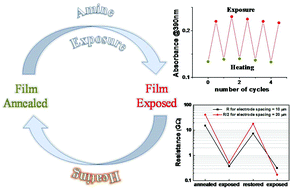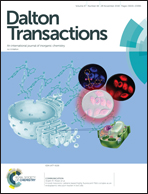Vapochromic and chemiresistive characteristics of a nanostructured molecular material composed of a zinc(ii)-salophen complex†
Abstract
The vapochromic and chemiresistive properties of a nanofibrillar molecular material composed of an amphiphilic ZnII Schiff-base complex, 1, are explored with the aim to obtain new materials with multifunctional properties. The solid 1 is characterized by the existence of two stable dimorphs, both exhibiting a nanofibrillar morphology. The thermal annealing of the ground solid 1 induces an irreversible lamellar-to-square columnar structural phase transition, as assessed by differential scanning calorimetry and X-ray diffraction analysis. When exposed to vapours of a Lewis base, spin coated films of the square columnar dimorph exhibit a marked change of both the optical absorption spectrum and the resistance, because of chemisorption of the Lewis base with the formation of 1·Lewis base adducts. The chemisorbed material is easily restored by thermal heating (150 °C), inducing desorption of the Lewis base. The changes of the properties are reproducible in successive cycles of exposure/restoring. Therefore, the present contribution provides new insights into the properties of this molecular material, potentially useful as a sensor for volatile organic Lewis bases.



 Please wait while we load your content...
Please wait while we load your content...